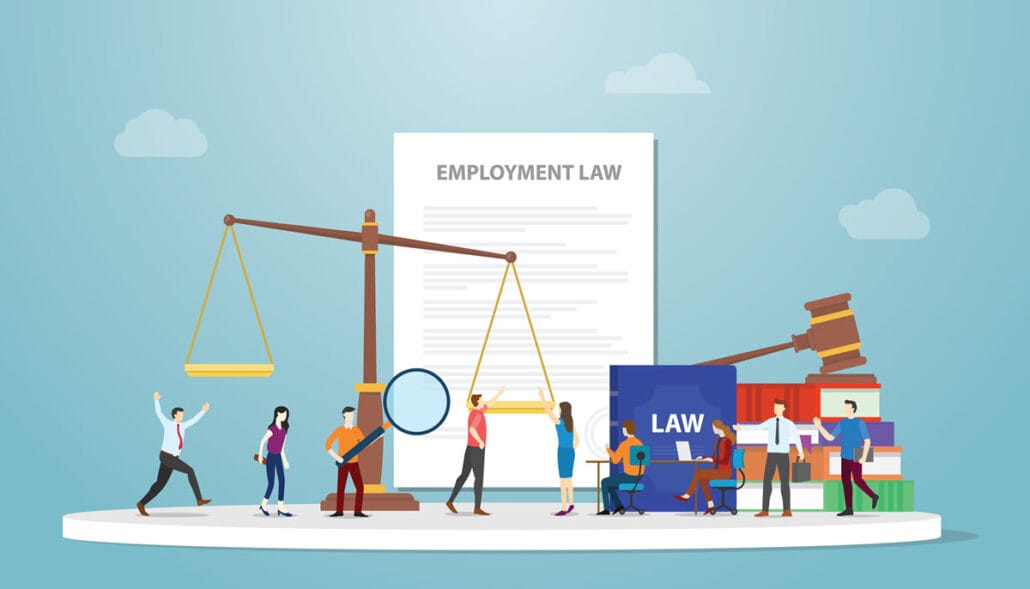Labor relations in HR involves managing the interactions and agreements between employers and employees. Effective labor relations ensure a productive and harmonious workplace, and protects employers and employees alike. In this article, we’ll explore what is labor relations in HR, and the key components, benefits, and tools that make labor relations effective.
Key Takeaways
- Labor relations encompass the agreements and interactions between employers and employees. Most often, they focus on fostering a mutually beneficial work environment through situations that involve collective bargaining and union engagement.
- The National Labor Relations Act (NLRA) establishes a legal framework that protects employees’ rights to unionize, while collective bargaining agreements ensure clear communication of rights and responsibilities between employers and employees.
- Strong labor relations enhance communication and employee satisfaction, ultimately leading to a positive workplace culture and increased loyalty among employees.
Defining Labor Relations in HR
Labor relations is a sub-function under the HR umbrella of responsibilities. It refers to the agreements and interactions between employers and employees. Preventing and resolving issues and fostering a positive work environment are its top goals. This area is crucial in human resource management, ensuring a harmonious and productive employer-employee relationship.
While employee relations typically refer to interactions between employers and individual employees, labor relations cover a broader scope, including regulatory policies, collective bargaining agreements, unions, etc. Knowledge of employee and labor relations are essential for HR departments so they can create policies and practices that encourage fairness, respect, and open dialogue. Even if an organization does not have an active union, knowledge of labor relations can go far in preventing a union from forming or ensuring that if one is formed, it is done in a manner that keeps the environment as healthy as possible.
Labor relations are vital in maintaining a positive work environment and boosting company morale and productivity. HR professionals who address employee concerns promptly and make the employee feel valued also facilitate higher satisfaction and retention. Successful labor and employee relations management protect both the organization’s and its employees’ rights by clarifying workplace rules and expectations.
About the National Labor Relations Act (NLRA)
The NLRA is a cornerstone of labor relations in the United States, providing a legal framework that protects employees’ rights to unionize and engage in collective bargaining. Under the NLRA, employers must avoid interfering with or discriminating against employees regarding their rights. The act ensures a fair and balanced employer-employee relationship, enabling employees to voice concerns without fear of retaliation.
Compliance with the NLRA sustains positive labor relations. Employee rights are also protected through this act.
Collective Bargaining Agreements
When employees are represented by a union, the union acts as an advocate for their rights and interests. Collective bargaining agreements (CBAs), facilitated by unions under the NLRA, outline key matters such as wages, working hours, and other conditions of employment. These agreements establish clear workplace policies and ensure both parties understand their rights and responsibilities.
The collective bargaining agreement plays a significant role in labor relations; employee and employer can easily understand the clearly defined rights and responsibilities of each other.
CBAs influence company wide policies and conditions, ensuring that employee rights are protected and that there is a mutual understanding of expectations. Managing these agreements helps HR management maintain a positive employee experience by establishing wages, benefits, and other perks in a way that the organization and its workforce can understand.
Key Components of Labor Relations

Effective labor relations involve several key components that ensure the smooth functioning of the employer-employee relationship. Fundamental aspects include managing employee contracts and addressing union-related grievances. Within these contracts, workplace discrimination, pay disputes, and workplace safety are the most challenging and complex types of issues. Successful handling of these components help boost employee motivation and enhance team dynamics.
HR professionals with experience in contract negotiations can better understand business strategies and labor costs, making them valuable assets to the organization.
HR departments must understand these components to foster a positive work environment and enhance employee experience. To better understand this role, the next section will explore the roles of employee unions, the importance of labor law compliance, and effective conflict resolution strategies.
Employee Unions
Employee unions play a crucial role in labor relations by safeguarding employees’ rights and negotiating better working conditions, pay, and benefits. They provide a collective voice for employees, allowing them to influence workplace policies and practices. Unions ensure employee feedback and concerns are addressed and promote a fair and equitable work environment.
Unions can significantly impact company culture by fostering a sense of community and shared purpose among employees. When employees feel that their rights are protected and their voices heard, it leads to higher satisfaction and retention rates.
Keep in mind that working with unions differs considerably, often depending on the size and type of the union. Every union is different. Unions at smaller facilities can be fairly easy to work with whereas larger union facilities can seem very strict and have a much more defined contract. The type of union can play a major difference in relations too, as can the company’s HR department approach and willingness to work with union requests.
Human resources teams need to collaborate with unions to maintain positive employee relations and address issues promptly and effectively.
Labor Law Compliance
Adhering to labor laws is fundamental in managing labor relations. To ensure compliance, human resources should be fully versed in every aspect of compliance, including:
- OSHA workplace safety
- NRLA laws including wages and unions
- Fair Labor Standards Act (FLSA)
In addition, the US Department of Labor highlights the most commonly applicable labor laws. Human resource departments should have a complete understanding of any applicable federal laws, as well as any state labor laws.
It’s essential for HR management to stay updated on labor laws to manage collective bargaining and grievances effectively. Modern HR tools, such as labor relations software, can significantly enhance compliance and reduce legal risks by automating processes and tracking grievances.
An HR department must ensure compliance to protect the organization and establish trust and transparency among employees.
Conflict Resolution Strategies
Effective conflict resolution is crucial for maintaining positive employee and labor relations. Handling employee relations issues requires listening to feedback and creating a supportive, inclusive work environment. HR professionals need to develop strong stress management and conflict resolution abilities to manage labor relations effectively.
Investigating and addressing conflicts, including potential disciplinary actions, is a key role of employee relations professionals. For HR professionals, especially in union contexts, effective communication and collaboration are vital to avert conflicts.
Utilizing data analytics can help organizations identify trends and mitigate potential issues before they escalate. Conducting surveys and recognizing performance significantly enhance employee relations.
Benefits of Strong Labor Relations

Strong labor relations bring numerous benefits to an organization, from better productivity to increased employee engagement. Integrating employee relations with company culture leads to higher satisfaction and productivity. A positive work atmosphere encourages employee loyalty, enhancing overall morale.
Aligning employee relations with company culture promotes effective communication and collaboration. A proactive approach in performance management and managing conflicts often leads to a more harmonious workplace environment.
HR professionals can develop critical skills in leadership and decision-making through their employee and labor relations responsibilities, contributing to the organization’s success.
Improved Communication
Effective communication is essential for maintaining positive employee relations and ensuring a clear understanding of workplace rules and expectations. Educating and communicating with employees clarifies rules and fosters transparency. Honest conversations between employers and employees foster positive relationships and encourage collaboration.
When communication channels are open and transparent, it leads to a more cohesive work environment where employees feel valued and heard. This, in turn, can lead to increased productivity and a more motivated workforce.
HR professionals facilitate communication and ensure employee feedback is taken seriously.
Increased Employee Satisfaction
Good employee relations lead to higher employee satisfaction and increased retention. Recognition and appreciation from leaders boost employee motivation and satisfaction. A positive work environment encourages self-improvement, boosting employee satisfaction. Satisfaction can lead to better outputs and revenues for the company.
A supportive workplace environment also reduces employee turnover and encourages loyalty. Creating a protective working environment fosters trust and equity, contributing to employee retention. Good labor relations enhance motivation and directly contribute to overall employee satisfaction.
Positive Company Culture
A robust workplace culture is significantly influenced by how employees are treated. Modern labor relations tools enhance HR’s ability to prevent issues, thereby improving workplace culture. A positive company culture fosters a sense of community and belonging among employees, enhancing overall employee well-being.
Employees who feel heard and valued are more likely to advocate positively for the company, signifying the importance of strong labor relations and how they contribute to building a positive company culture.
Role of HR Professionals in Labor Relations
HR professionals handle tasks such as contract negotiations, arbitration, mediation, grievances, strikes, and collective bargaining in managing labor relations. In most organizations, these efforts are typically managed by the human resources department. Alternatively, a dedicated employee relations manager may oversee labor relations, while delegating human resources professionals to facilitate certain communications and address employee concerns about employee and labor relations. The public relations department may also be involved, especially if situations arise that attract media attention.
HR law establishes a legal framework that supports employee relations. It regulates issues like discrimination, harassment, and employee rights. HR professionals are responsible for advising management, developing policies, and handling disputes concerning legal matters. They address employees’ needs and concerns, manage conflicts, and improve communication to foster positive employee relations.
Essential Skills for HR Professionals
Effective communication is the most important skill human resources professionals should have for fostering positive relationships between employers and employees. HR professionals must create open communication channels and encourage feedback in employee and labor relations. By communicating effectively, HR can convey information clearly, resolve conflicts, and foster positive relationships.
Other skills and characteristics that will improve the efficacy of HR management in employee and labor relations include:
- attention to detail
- conflict management
- communication
- active listening
- trustworthiness
- impartiality
- positivity
- organizational psychology
While not essential in most cases, knowledge of organizational psychology can complement both employee and labor relations in human resources departments.
Advanced Tools for Managing Labor Relations

Modern tools and technologies can significantly enhance HR departments’ efficiency in managing labor relations. Labor relations software allows HR professionals to manage union issues and grievances effectively with centralized, cloud-based solutions. Advanced HR technologies and analytics tools enhance decision-making and risk management in labor relations.
The integration of these modern tools improves HR’s ability to maintain constructive labor relations, ultimately benefiting the organization. This section will explore the role of labor relations software and data analytics in managing labor relations effectively, and some of the top tools available for your HR department.
Labor Relations Software
Labor relations software with automated workflows streamlines tasks and improves operational efficiency. It can also ensure compliance with labor laws by detecting regulatory issues. Popular software tools that enhance the efficiency and accuracy of HR processes include:
- HRAcuity
- LaborSoft
- Avature
- Tyler Technologies
Automating processes with labor relations software minimizes errors and saves time, and fills in potential gaps in compliance.
Data Analytics Tools
Data analytics enhances employee and labor relations by providing insights into workplace trends and issues. By identifying these trends early, organizations can address potential issues proactively – before complaints are made with unions. Some of the workforce data analytics tools that enhance employee relations include:
- FaceUp
- LightCast
- Gusto
Leveraging data analytics in employee relations leads to a more informed and responsive approach to labor relations and employee management.
Summary
Understanding labor relations in HR is pivotal for creating a harmonious and productive workplace. By defining labor relations and exploring key components such as the National Labor Relations Act, collective bargaining agreements, and the essential role of employee unions, we can appreciate the complexities involved. Effective management of labor laws compliance and conflict resolution strategies further underscores the importance of HR professionals in this domain.
The benefits of strong labor relations are manifold, including improved communication, increased employee satisfaction, and a more positive work culture. HR professionals that are equipped with essential skills and best practices play a crucial role in fostering positive employee relations. Advanced tools like labor relations software and data analytics provide the necessary support to manage these relations efficiently. Ultimately, building a positive company culture through robust labor relations leads to a more engaged and motivated workforce, driving the overall success of the organization.


